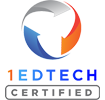
What does rigor look like in the online classroom?
Seems like a simple question – doesn’t it? Maybe one that could even be answered by four or five bulleted items – right? Yes . . . except for one small detail: How do we define rigor in the first place?
That’s not a simple question.
Look at a few different ways rigor is sometimes perceived:
- Standards: rigorous courses come from rigorous standards
- Difficulty: the more difficult a course is, the more rigorous it is
- Quantity: The more work students must complete, the more rigorous.
And still, at other times, it’s all of the above! Those advocates say that rigor increases as the difficulty of the content AND quantity of the work in the course increase to meet more rigorous standards.
Truly, though, the above perceptions of “rigor” often tend to achieve the exact opposite of what is intended: students feel emotionally and cognitively disengaged from any possibility of learning.
Here are the realities behind those mistaken beliefs:

Rigorous standards = rigor? Rigor is not found in rigorous standards alone; rather, it is found in how we ask students to reach the standards.
Difficult content and difficult courses = rigor? Rigor is not found in content or courses that are harder. Rigor is found in relevant and thought-provoking content and courses that meet students where they are and help them stretch to deeper understanding.
More work = rigor? Rigor is about the quality, not the quantity of work that the kids do. More work is just . . . well . . . more work!
Consider the CCSS ELA-Literacy Standard RL 8.1 Cite the textual evidence that most strongly supports an analysis of what the text says explicitly as well as inferences drawn from the text.
Here is one online task and two online assessments that attempt to address the standard:
- Students are required to view a pre-recorded video lecture of the teacher defining the concepts of evidence, explicit evidence, and inference which includes examples from a short story the students are required to read before viewing the lecture.
- Students are then required to complete a graded worksheet in which they locate and analyze one example of explicit evidence and two inferences from a second passage chosen by the teacher from the same short story.
- Students are then required to complete a graded discussion board prompt where they locate and analyze one more example of explicit evidence and two inferences from a third passage chosen by the teacher from the same short story and explain their findings to their classmates.
Yes, the standard is rigorous. But, is how the teacher asks the students to reach the standard rigorous? No. Has the content been scaffolded? No. Has the quality and not just the quantity of the work been addressed? No.
 Listening to a lecture without being able to ask clarifying questions, completing a teacher designed worksheet without any sort of scaffolding, and responding to a teacher-constructed prompt with all passages chosen by the teacher are not rigorous tasks. They are merely hard. These tasks remain under the ownership of the teacher, and they do not provide the student with any sort of authentic learning experience. The idea is to challenge students without frustrating them, helping them build and strengthen their skills and knowledge systematically.
Listening to a lecture without being able to ask clarifying questions, completing a teacher designed worksheet without any sort of scaffolding, and responding to a teacher-constructed prompt with all passages chosen by the teacher are not rigorous tasks. They are merely hard. These tasks remain under the ownership of the teacher, and they do not provide the student with any sort of authentic learning experience. The idea is to challenge students without frustrating them, helping them build and strengthen their skills and knowledge systematically.
How can these assignments be done differently, rigorously? Although these are not the only assignments that could be included in a unit on inference, consider these revisions of the assignments provided above:
- Using a synchronous lecture as an introduction to the concepts instead of a pre-recorded one so the teacher can make the discovery of the explicit evidence and inference in the text visible (and in real time) for the students. The students can then ask clarifying questions
- Making the worksheet a formative assessment and then scaffold as necessary
- Having students complete a discussion board prompt using a familiar fairy tale (shortened) or Aesop’s fable from a list provided by the teacher where they locate and analyze one example of explicit evidence, one inference, and explain their findings to their classmates. Then have the students copy and paste one of their classmates’ responses into a Word doc and respond to it as an “evaluator” explaining why the finding is correct or incorrect. This would later be submitted to the teacher to be graded.
- As a summative assessment, having students create videos analyzing the explicit evidence and inferences in a short story of their choosing from a list provided by the teacher. Create a pre-recorded video for the students to use as a model
- Providing a rubric for the students for summative assessments
- Having students work in pairs
 Rigor in the online classroom, then, is not defined by rigorous standards, or the difficulty of the work, or the quantity of the work. Rigor is defined by the authentic and meaningful challenges that students are provided. Expecting students to learn at high levels, supporting students as they learn at high levels, and allowing students to demonstrate their learning at high levels (Blackburn, 2008) are the hallmarks of rigor.
Rigor in the online classroom, then, is not defined by rigorous standards, or the difficulty of the work, or the quantity of the work. Rigor is defined by the authentic and meaningful challenges that students are provided. Expecting students to learn at high levels, supporting students as they learn at high levels, and allowing students to demonstrate their learning at high levels (Blackburn, 2008) are the hallmarks of rigor.
Blackburn, B. R. (2008). Rigor is not a four-letter word. Larchmont, NY: Eye on Education.

Valerie is a curriculum developer at StrongMind. In her previous life, she taught English and composition in a variety of online and on-ground classrooms, from middle through high school to college. She earned National Board certification while a teacher as well as her K-12 principal certification. She is co-author of a self-esteem enhancing curriculum for middle and high school students, and she remains passionate about engaging students by starting from where they are, not from where we want them to be.





